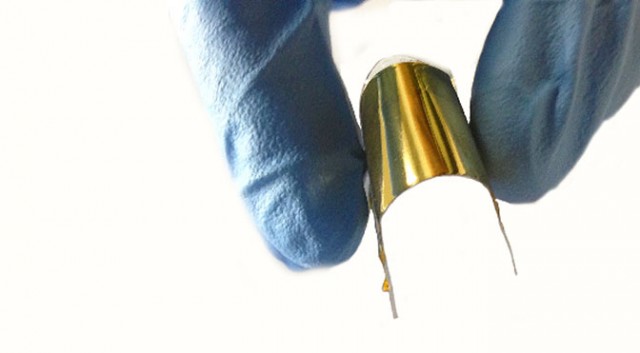
What if mobile electronics were so self-reliant, that they could completely power themselves through locomotion? What if moving your body was all it took to charge your wearables, allowing you to create a truly mobile experience and do away with wall tethers and reserve battery packs? As it turns out, a new device presented at the 2015 MEMS conference in Europe can fulfill both of those requirements by harvesting the electrical charge generated when a wearer performs daily activities like walking, speaking, or lifting an object.
Developed at the National University of Singapore, the flexible nanogenerator resembles a small, postage-stamp sized patch that attaches to your skin and generates up to 90 volts of open circuit voltage from static electricity— enough electricity to power most small wearables. To demonstrate the device’s effectiveness, electrical and computer engineering professor Chengkuo Lee, together with his colleagues, used the device to create a self-powered wearable sensor that tracks user’s motion and physical activity.
To accomplish this goal, the device leverages a phenomenon called the triboelectric effect, which states that an electrical charge builds up on two dissimilar surfaces that are in close enough proximity to one another to create a frictive contact. When the surfaces are pulled away or flexed, a potential difference is created and a current starts flowing between them. It’s the same principle that causes your hair to stand up when a balloon is rubbed against it. Lee's nanogenerator produce energy by collecting the current flow using electrodes made from a nanoscale layer of gold film.
By using skin as one of the triboelectric layers, the researchers can cut down on the material used to build the device, thus saving size and materials. “Skin, the most abundant surface on a human body, is a natural choice for one of the triboelectric layers,” stated researcher Lokesh Dhakar, on of Lee’s graduate students, to the IEEE Spectrum report. The team created the opposite surface that comes into contact with the skin using a thin silicone layer covered with thousands of flexible pillar-like structures.
During the initial stage of testing, the researchers observed that patches attached to subjects throats and forearms produced 7.5 V and 7.3 V through the everyday muscle movements associated the body parts: grasping objects and speaking. Conversely, tapping the device directly generated the highest voltage of 90 V — enough to power 12 LEDs.
From lighter and thinner device to powering small wearables indefinitely, the benefits of the nanogenerator are obvious. Since the polarity and charge strength of the triboelectric effect varies according to surface material used, perhaps one day we’ll create a new material that will permit the nanogenerator to power even our smartphones.
Source: IEEE Spectrum
Advertisement
Learn more about Electronic Products Magazine





